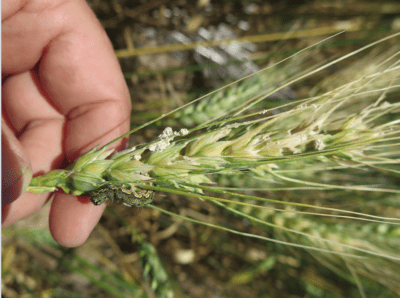 The Grains Research and Development Corporation (GRDC) is warning growers in Queensland and New South Wales to be aware of the potential for large populations of Helicoverpa armigera in winter cereal crops. Large flights of helicoverpa have occurred in these regions over the last two weeks and longer in some districts.
The Grains Research and Development Corporation (GRDC) is warning growers in Queensland and New South Wales to be aware of the potential for large populations of Helicoverpa armigera in winter cereal crops. Large flights of helicoverpa have occurred in these regions over the last two weeks and longer in some districts.
This has seen significant egg lays and larval populations in winter crops, including the winter cereals. In wheat and barley there is the potential for crop losses, with estimates of one larvae per m2 potentially causing 15kg grain loss/hectare.
Queensland Department of Agriculture and Fisheries Queensland (DAF) principal entomologist Dr Melina Miles said while it was not unusual to find both helicoverpa and armyworm in cereal crops, correct identification of the species present was very important as it influenced damage potential and choice of control measures.
“Virtually all of the helicoverpa in cereals are Helicoverpa armigera. This is important to know because this species has developed resistance to many of the older insecticide groups that are registered for helicoverpa control in winter cereals,” Dr Miles said.
“Helicoverpa larvae hatch from the eggs in three to five days and develop through the grain fill stage over 14 to 28 days, depending on temperature.
“In crops where the grain is mature and drying down, larvae tend to graze on the grains and in crops where the grain is still filling or milky-soft, larvae have the potential to burrow into the grain and consume most it.”
As there is no trial data from cereal crops, the old sorghum damage value of 1.5 g grain loss per larvae is used as a best-bet estimate of the damage the helicoverpa can cause, according to Dr Miles.
“To put this damage value into perspective the damage value for sorghum was recently revised upwards from 1.5 to 2.4 g per larva, the value for chickpea is 2.0 g per larvae, and the latest mungbean value is 3.5 g per larva,” Dr Miles explained.
“That said, using the of 1.5 g per larva value is not unreasonable given the observation of reduced feeding as the crop matures, and while potentially on the conservative side, it does provide sound guidance for decision-making.”
Dr Miles warns that where the cost of control exceeds the value of the potential loss, treatment is not recommended.
“As Helicoverpa have historically had high resistance to pyrethroids, a pyrethroid is unlikely to provide satisfactory control, particularly if larvae are greater than 5 mm in length. While resistance levels to pyrethroids may have declined in recent years, control of medium-large corn earworm larvae using pyrethroids is not recommended.
“Methomyl is another registered option at 1.5 to 2.0 L/ha, with the higher rate against larvae greater than 20 mm in length. It has contact action only, but that is not a problem because reinfestation is most unlikely. Resistance to carbamates (methomyl) has been a problem in the past, so any decision to use this product should be based on its recent performance against pest infestations.
“Nuclear polyhedrosis virus (NPV) such as Vivus Max® is effective against Helicoverpa armigera at a 75-100 mL rate. If most of the larvae in a wheat crop are less than 10 mm (medium); then NPV is an option for control. Look to apply NPV in the warmer part of the day and the inclusion of Optimol® may increase the efficacy against larger larvae.
With the limited options for control, and the potential for reduced efficacy because of resistance, there are several considerations when it comes to control.
“If crops are still green and four to six weeks from harvest, small larvae will have time to develop to a damaging size before the crop is less susceptible to damage. With large populations of small larvae in this scenario, the use of NPV has merit, either on its own or in combination with another option.
One approach would be to treat above threshold populations early when larvae are smaller and down in the canopy, but potentially more susceptible to the insecticide.
Alternatively, waiting until larger larvae are more exposed on the heads may make aerial application more viable, but does run the risk of lower efficacy because of difficulty getting penetration into the canopy, resistance; and risks incurring grain loss before the control is implemented.
Source: GRDC. More information can be found at http://thebeatsheet.com.au/crops/grains/winter-cereals/high-helicoverpa-armigera-in-winter-cereals/

HAVE YOUR SAY